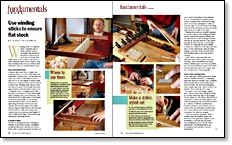Use Winding Sticks to Ensure Flat Stock
A matched pair of straight and parallel sticks can reveal the twist and wind in your lumber
Synopsis: Winding sticks have been around a long time, but they have not outlived their usefulness, even in a machine-based shop. They make twist and wind visible, and they have a host of other uses as well, including checking a board for a consistent angle and finding the high points in a board too wide for the jointer. Author Doug Peterman made his own winding sticks, and he explains how you can make a stable, stylish set for yourself.
Winding sticks are simplicity itself: a matched pair of sticks carefully made to be straight and parallel on all surfaces. Placed across each end of a board, they make it easy to see if there is any twist or wind. Although they’ve been around a long time, winding sticks have not outlived their usefulness, even in a machine-based shop.
They make twist visible
It doesn’t take much twist to make your project go awry. In a 12-in.-wide frame-andpanel door, a twist of just 1° in the stiles can cause one corner of the finished door to stick out 3⁄16 in. One degree of twist is fairly obvious in a wide board but can’t be seen in a narrow one. Winding sticks placed across the ends of a narrow board make the board appear wider so that the twist is easy to see.
Using the sticks is straightforward. With the board on a surface at about waist height, place a winding stick across each end. The sticks should be at right angles to the length of the board and parallel to one another. From several feet away, crouch down to sight along the length of the board and examine how the top edges of the sticks line up. Aligned edges indicate that the ends of the board are in the same plane; any variation shows the direction and degree of twist. It helps if the edges of the sticks being viewed are contrasting woods.
A variety of uses
The key to dealing with twist is finding it, whether in the project stock or in finished assemblies like doors and drawers. If you flatten slabs or glued-up panels by hand—or if you need to handplane a flat reference face on a board that’s too wide for your jointer—winding sticks will show the high spots. If you use a handplane to dress or joint the edge of a board, frequent checking with the sticks will help you keep the proper angle along the length of the edge.
Winding sticks are also valuable insurance for anyone using modern milling machines. Jointers produce flat surfaces initially, but the exposed wood will exchange moisture with the air and may pull out of flat almost immediately. The best way to ensure flat boards is to rough-mill the stock slightly oversize, let it settle for a few days, and then mill it to final dimensions. After an initial milling, I randomly check several boards with winding sticks to see if the stock is twisting.
From Fine Woodworking #177
For the full article, download the PDF below:
Fine Woodworking Recommended Products

Starrett 12-in. combination square

Stanley Powerlock 16-ft. tape measure






















Log in or create an account to post a comment.
Sign up Log in